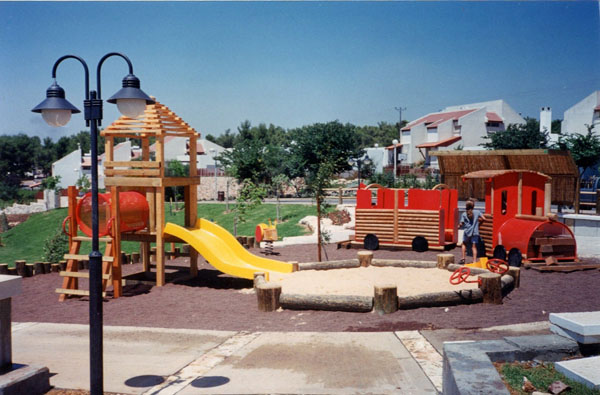The serious business of playtime is the focus of a new exhibition opening on April 16th, “Playing at Design Museum Holon”, that explores two fields in which designers for children operate: contemporary illustration and playgrounds.
The playground exhibit in the Museum’s Upper Gallery presents seven sensory playground challenges, tracing their development; where they began and how they evolved from public parks through fenced areas to adventure spaces.
Chief Curator Galit Gaon states, “We will describe urban playing spaces from their inception sometime between the 16th and 17th centuries to the present day, the beginning of the twenty-first century, by means of a map presenting a taste of the great wealth that exists in playgrounds.

“Concurrently, by changing the physical space of the gallery, we invite visitors to a series of focused experiences, points to ponder with reference to the concept of play, and its importance and significance for children and adults alike.”
“This exhibition is a call for a candid discussion on our place, on the right to dream, the freedom to experiment and experience, the opportunity to play, and on the alternative of growing up happy.”

“In the Upper Gallery we seek to reawaken in visitors the question concerning the fate of playgrounds”, Gaon continues. “Why and when did they change in Israel from a place of adventure to a collection of ‘apparatuses’? What should we, designers, planners, parents, and decision makers in Israel, do in order to restore playgrounds to their appropriate place – as a wonderful, imaginative alternative for older and younger children, and parents and children to play together.”

“In this exhibition we invite visitors, designers, city planners and mayors, municipal engineers and safety consultants, parents and educators, young and old alike, to return to the magic of playgrounds for a while and to choose well.”

The topic is not just theoretical. In Jerusalem, residents of the Kiryat HaYovel neighborhood last month protested against the closure of Rabinovich Park and its iconic Monster slide. The neighbors believe — and issued a petition to that effect — that the Municipality and the Ministry of Transportation plan to destroy the park to make room for the Red Line of the new Light Rail train.
Originally named “The Golem” and known locally as HaMifletzet “monster”), the slide is the neighborhood’s claim to fame, a whimsical playground sculpture by French-Jewish artist Niki de Saint Phalle.

According to a report by architect Michael Yacobson published last month (in Hebrew) in Xnet of Yediot Aharonot, the Jerusalem Transport Master Plan team (JTMT) was surprised by the Kiryat Yovelites actions, stating that while the “Red Line” would connect the axis of Herzl Boulevard and the neighborhoods of Kiryat Yovel, Kiryat Menachem, surrounding parks and eventually Hadassah Hospital in Ein Kerem — a welcome move — it would endanger neither the park nor the Monster.
Yacobson notes that development requires not only transparency, informing residents and hearing their wishes and vision but also “presents an opportunity to revisit the garden and redesign it to suit the leisure time needs of the early 21st century… Xnet requested the Municipality present its development plan for the park to clarify its content — the request was not answered.”
The exhibition “Playing at Design Museum Holon” will be held as part of Design Week Holon 2014 which runs from April 16 to June 07, 2014. The petition “Do Not Destroy Monster Park in Kiryat Yoval” can be found at Atzuma.com. As of today, there were 4,585 signatures out of a projected 5000.
Images: HaMifletzet: Wikipedia. All others: Holon Museum of Design.














